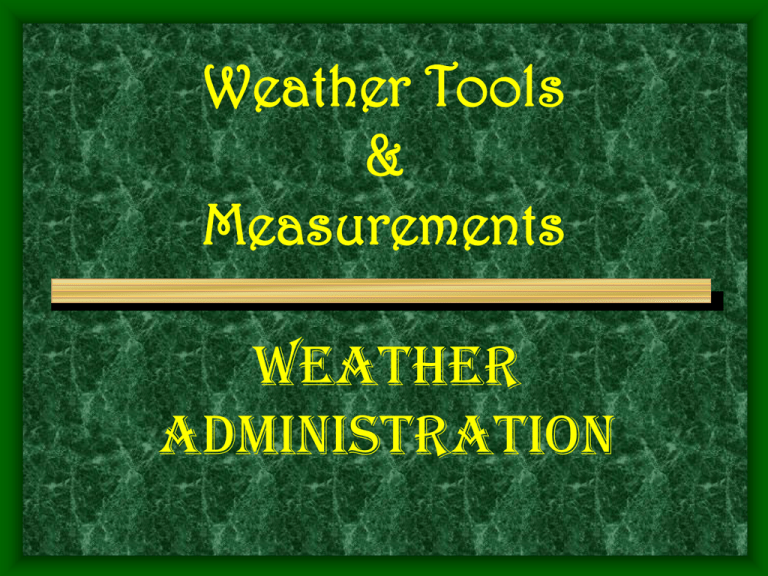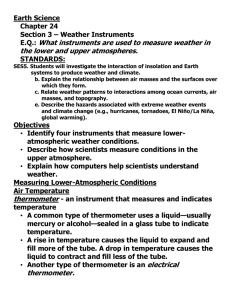Weather Tools & Measurements Weather
advertisement

Weather Tools & Measurements Weather Administration Essential Questions • What are they? • What do they measure? • What are their units • Who observes the weather for us? Instruments of Weather Make a list of five of the most common weather instruments that you can think of. The Most Common Weather Tools Are: • Thermometer • Wind Vane • Anemometer • Barometer • Rain Gauge • Psychrometer • H.V.S. Thermometer • A thermometer is a weather tool used to measure the temperature • It’s unit of measurements are degrees Celsius or degrees Fahrenheit Wind Vane • By observing wind vanes and compasses, we can know the direction of the wind. • Compass rose and/or 0 to 360 degrees Anemometer • An anemometer is a weather tool that measures wind speed. • Km/hr and m/hr Barometer • Barometers are important to measuring air pressure. • millibars (mb) or inches of mercury. High – Fair Low - Foul Rain Gauge • A rain gauge is a weather tool used to collect rain. • Rulers measure frozen forms of precipitations • Centimeters or inches Psychrometer • A psychrometer is used to measure humidity or moisture in the air. • Percent (%) moisture held in the air. High Volume Sampler • H.V.S. samples air quality. • Accessories can be added to monitor any type of pollutants • • • • • • • • • Other tools are… Weather Maps Radar Doppler Radar Satellites / GPS Weather Balloons / Radiosonde “Personal observations” Almanac Lightening Detector Weather Rope or Weather Rock Weather Maps • A weather map displays various meteorological features across a particular area at a particular point in time. Such maps are used for research and weather forecasting purposes. Radar and Doppler • Weather radar, also called weather surveillance radar (WSR) and Doppler weather radar, is a type of radar used to locate precipitation calculate its motion, estimate its type . Satellites and G.P.S. • The weather satellite is a type of satellite that is primarily used to monitor the weather and climate of the Earth. Weather Balloons and Radiosonde • A weather or sounding balloon is a balloon which carries weather instruments aloft to send back information by means of a small, expendable measuring device called a radiosonde. Personal Observations • Most important tool in science. Almanac • Records and predicts astronomical events the rising and setting of the Sun, lunar phases, tides, weather, and other phenomena with respect to time, climate and seasons. • Helps with crop planting and harvest schedules. Lightening Detector • Detects lightening strikes within a certain mileage perimeter. Weather Rope / Weather Rock Personal Observations NOAA??? National Oceanographic and Atmospheric Administration Who Administers the Atmospheric Conditions??? • The National Weather Service is a component of the National Oceanic and Atmospheric Administration (NOAA). • NOAA is an Operating Unit of the U.S. Department of Commerce. Organizational Structure… U. S. Department of Commerce (International Trade, US Business Growth, Aid in Technological Advancement) National Oceanic and Atmospheric Administration (NOAA) (Climate, Ocean Life, Satellites, Research) National Weather Service (Forecasts, Warnings, River Data, Weather Safety) International Responsibilities The World Meteorological Organization (WMO) is a specialized agency of the United Nations. It is the UN system's authoritative voice on the state and behavior of the Earth's atmosphere, its interaction with the oceans, the climate it produces and the resulting distribution of water resources. Reading a Weather Map and Station Models. Essential Questions: • What are the symbols used in reporting the weather? • What is a station model and how is it read? SWBAT • Analyze station models and their symbols • Construct station models • Complete an online station model activity Station Model Weather Condition Symbols Cloud Coverage Symbols Precipitation Symbols Cloud Type Symbols Barometric Shorthand • http://regentsearth.com/Illustrated%20ESR T/Page%2013%20%28Weather%20Map%2 0Symbols%29/Pressure.htm Wind Conditions - Wind Barb Station Models Game • http://itg1.meteor.wisc.edu/wxwise/Ackerm anKnox/chap1/station-1.html • http://cimss.ssec.wisc.edu/wxwise/station/p age5.html




